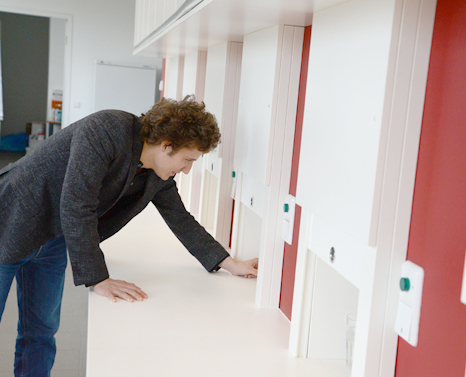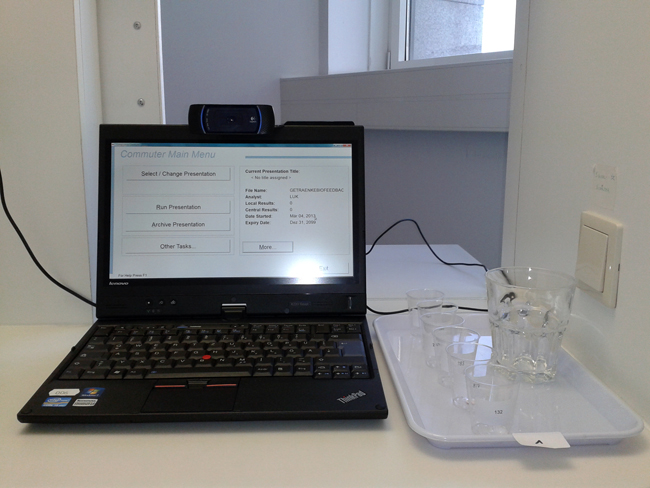Measuring the unconscious
What do facial expressions, eye tracking, and the autonomous nervous system reveal? Observational methods offer new possibilities for consumer research.

Lukas Danner is searching for the consumers' unconscious reactions.
Is it possible to observe whether something tastes good? If so, how good? What do facial expressions and other unconscious body reactions reveal about personal liking and disliking? Does a person’s visual behavior forecast which dessert he or she will choose at a buffet?
European Sensory Network researchers at the University of Natural Resources and Life Sciences in Vienna, Austria are pursuing just such questions.
The stomach decides before the brain
The answer to the question “Why did you choose this food over another?” is often quite detailed. However, on closer examination, they contain only a small portion of the truth. Most spontaneous choices are not made consciously but subconsciously. Such unconscious processes are quick and effortless, to a great extent unintentional, and are scarcely controllable. The emotions play an important role that seldom penetrates the conscious mind. It seems that the stomach decides before the brain. In order to follow the trail of factors influencing the decision, the consumer researchers are interested in finding methods that would allow them to document and analyze such unconscious processes. In psychology it is well-known that methods such as measuring the physiological responses of the autonomous nervous system (ANS) are particulaily suited for this purpose: changes in blood pressure, skin resistance, heart rate, and unconscious spontaneous eye movement as well as facial reactions can all be monitored and analyzed.
Listen to the heart beat
Dr. Lukas Danner and co-workers at the Department of Food Science and Technology at the University of Natural Resources and Life Sciences (BOKU) in Vienna are determining how such research technologies can be put to good use in consumer science.
In a classic setting in which the subject group sampled six different juices, the researchers measured skin conductance levels, skin temperature, heart rate, pulse volume-amplitude, and recorded the complete process with a webcam. The subjects were instructed to first savour the juice’s taste, then to raise their hand and without speaking, make a facial expression indicating how good the particular juice tasted. Finally, the subjects rated the taste on a nine point scale.
It could be shown that not only did the test subjects consciously react to the different fruit and vegetable juices; they also differentiated their likes on certain ANS parameters. Juices that were less appealing to the test persons tended to produce a higher increase in skin conductance levels than better liked juices. Skin conductance is an indication that the autonomous nervous system has been activated, and reflects the fact that the test subjects reacted to an unpleasant taste with marked bodily tension, whereas they remained relaxed when drinking a pleasant-tasting sample.
In this case there was a weak negative correlation that made it possible to discriminate unpleasant from pleasant and unpleasant from neutral samples, but not to separate the pleasant from the neutral samples. The researchers found no significant effects by the skin temperature, heart rate, and pulse volume amplitude parameters.
 The Face Reader automatically analyzes the six basic facial expressions.
The Face Reader automatically analyzes the six basic facial expressions.
Hard to read “poker faces”
In evaluating the facial reactions, study leader Lukas Danner and his colleagues were not only interested in explicit facial expressions but also in the spontaneous implicit facial reactions to the tasting samples. With the help of Noldus FaceReader software, both were analyzed and compared. What was striking was that not all of the subjects exhibited a measurable facial expression during and after the tasting. Around 15 percent made a “poker face”, and did not discernably alter their facial expression.
With the other 85 percent, the unpleasant samples caused markedly stronger reactions than did the pleasant samples. All the test subjects clearly exhibited more spontaneous negative than positive emotions. Danner deduces that, “When testing for perceptions of taste, spontaneous facial expressions are a good indicator for disliking, but not for liking.” Especially since some of the subjects, seemingly paradoxically, reacted by grinning or laughing more often by the unpleasant than the pleasant samples. When asked why, they replied that they had responded out of surprise because it had tasted differently than they had expected.
However, when the subjects were instructed to make facial expressions to the drinks, they reacted to the pleasant samples with smiles and laughter. Thus the negative, neutral, and positively rated samples could be much more clearly differentiated by intentional facial expressions than by spontaneous facial reactions.
In a further study the researchers presented the test subjects with three different variously colored desserts. This time they tracked eye movement during the process of choosing. Whereas the relative position of the desserts to one another had no measurable influence on gazing behavior, color had significant influence. The Austrian test subjects preferred the varieties with more subdued coloring. Lukas Danner explained that the finding indicated that, “Color awakes expectations and is often interpreted as evidence of the product’s quality. Consumers prefer products that coincide with their recollections, especially their previous experiences.”
No love at first sight
The number of fixations and the duration of the gaze within a defined area of interest (AOI) correlated positively with the selection behavior. Products that were looked at more often and for a longer period of time were subsequently chosen much more often. The location and duration of the first fixation had no influence. In other words, the respective first glance gave no indication of the final choice. How the attention was distributed and maintained was reflected in the number of fixations and the duration of the visual orientation directed at a specific area.
More specific questions can be examined with these methods. For example, how much do specific intrinsic and extrinsic factors influence the focus of attention, and are there special group-specific differences? Lukas Danner comes to the following overall conclusion: “Our studies indicate that above all, the automatic analysis of facial expressions using FaceReader software and eye-tracking are extremely promising methods. They can be helpful in further studies, affording a deeper look into dietary behavior. The fact that the ANS parameter does not always correlate with facial expressions and direct ratings of liking could mean that it provides additional information to the introspective ratings of the test subjects. However, this question still needs to be studied in more in detail.”
Source:
Lukas Danner
Observational methods in the food context
Application and evaluation of automatized facial expression recognition, Eye-Tracking and ANS measurement techniques
(Doctoral thesis)
Institute of Food Science Department of Food Science and Technology
University of Natural Resources and Life Sciences, Vienna August, 2014